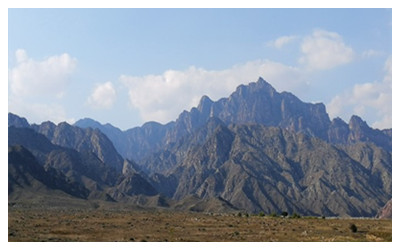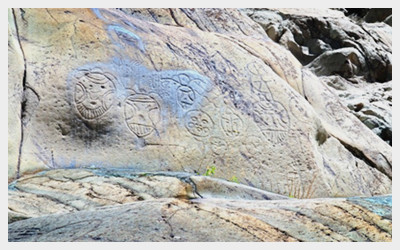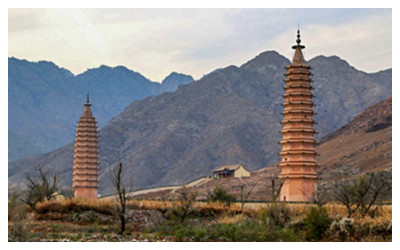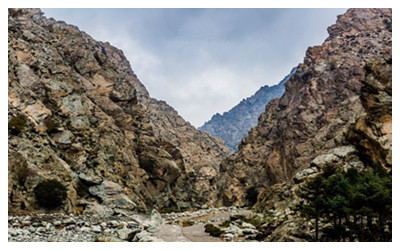Helan Mountain is a north-south mountain range located in the boundary of Ningxia and Inner Mongolia, which is an important geographical boundary in northwestern China. It stretches 220 km from north to south and 20 to

40 km from east to west, and the elevation is 2,000~3,000 m . The east side of the mountain is towering and precipitous, and the west side of it is flat and gentle. The mountain is majestic and looks like horses galloping.
Suyukou National Forest Park
Suyukou National Forest Park is located to the west of the Rock Paintings. Below are main spots in this park: Helan Mountain Museum,Sanqing Taoist Temple, Cherry Valley.
Helan Mountain Museum is a modern museum with the theme of the mountain’s animal and plant resources, geological vicissitude, history and culture. There are 13 halls in the museum with more than 400 exhibits. Sanqing Taoist Temple is an archaize building with red walls and grey tiles. This Taoist Temple had a history of 800 years but was ruined by war. It was rebuilt in 2004. Cherry Valley is 2 km long spot filled with wild cherry trees.
Rock Paintings of Helan Mountain
 From early times, it is where ancient northern minorities lived, multiplied and worked. They have chiseled the scenes of their living and production on rocks in Helan Mountain, which reproduces their social customs and life interests. Along the 222 km long Helan Mountain interior place, covering over ten hill mouths ranging from north to south, there are over 20 groups of rock paintings which embrace over 10,000 paintings. They are said to be the masterpieces of Qiangrong, Xianbei, Xiongnu, Yuezhi and other minority groups who created them during Spring and Autumn Period (770 BC-476 BC) to West Xia Dynasty (1038-1227).
From early times, it is where ancient northern minorities lived, multiplied and worked. They have chiseled the scenes of their living and production on rocks in Helan Mountain, which reproduces their social customs and life interests. Along the 222 km long Helan Mountain interior place, covering over ten hill mouths ranging from north to south, there are over 20 groups of rock paintings which embrace over 10,000 paintings. They are said to be the masterpieces of Qiangrong, Xianbei, Xiongnu, Yuezhi and other minority groups who created them during Spring and Autumn Period (770 BC-476 BC) to West Xia Dynasty (1038-1227).
The rock paintings have abundant contents and painting styles, and they are vivid and full of imaginations. The paintings bring us precious information of ancient human beings and an enjoyment of art.
 Double Pagodas in Baisikou
Double Pagodas in BaisikouThe Double Pagodas in Baisikou are located in Baisikou of Helan Mountain. They are the best-preserved Western Xia (1038-1227) pagodas with an age of 1,000 years old. These pagodas are extremely rare treasures in Chinese pagodas, which play important roles in archaeology, Buddhism, research and appreciation.
The east pagoda, with a height of 39 m, is a regular octagonal building with 13 floors, and embossments of animal heads are under every eave of every floor. The colored animal heads have colored drawing rosary in their mouths. The west pagoda, with a height of 41 m, is a little thicker than the east one. This pagoda is also 13 floors with a niche in every floor. The walls are filled with delicate Buddhism pictures. Both of them are brick pagodas. Sanskrit, Tangut script and coins in Yuan Dynasty (1271-1368) were found in the pagodas.
 Gunzhong Pass
Gunzhong Pass Gunzhongkou is located in the east of the mountain. It is the most famous summer resort in Ningxia. The pass is ringed on three sides by mountains and opens on the east, which looks like a thwart bell. There is a hill in the middle of the area, which looks like the striker. Therefore the place is called “Gunzhong”, which means a rolling bell in Chinese.
Travel Tips
Add: in the boundary of Ningxia and Inner Mongolia
Opening Hours: 08;00-18;00
Entrance Fees: CNY220
 40 km from east to west, and the elevation is 2,000~3,000 m . The east side of the mountain is towering and precipitous, and the west side of it is flat and gentle. The mountain is majestic and looks like horses galloping.
40 km from east to west, and the elevation is 2,000~3,000 m . The east side of the mountain is towering and precipitous, and the west side of it is flat and gentle. The mountain is majestic and looks like horses galloping.
 From early times, it is where ancient northern minorities lived, multiplied and worked. They have chiseled the scenes of their living and production on rocks in Helan Mountain, which reproduces their social customs and life interests. Along the 222 km long Helan Mountain interior place, covering over ten hill mouths ranging from north to south, there are over 20 groups of rock paintings which embrace over 10,000 paintings. They are said to be the masterpieces of Qiangrong, Xianbei, Xiongnu, Yuezhi and other minority groups who created them during Spring and Autumn Period (770 BC-476 BC) to West Xia Dynasty (1038-1227).
From early times, it is where ancient northern minorities lived, multiplied and worked. They have chiseled the scenes of their living and production on rocks in Helan Mountain, which reproduces their social customs and life interests. Along the 222 km long Helan Mountain interior place, covering over ten hill mouths ranging from north to south, there are over 20 groups of rock paintings which embrace over 10,000 paintings. They are said to be the masterpieces of Qiangrong, Xianbei, Xiongnu, Yuezhi and other minority groups who created them during Spring and Autumn Period (770 BC-476 BC) to West Xia Dynasty (1038-1227).  Double Pagodas in Baisikou
Double Pagodas in Baisikou Gunzhong Pass
Gunzhong Pass  Ask Questions ?
Ask Questions ?